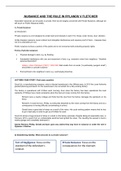Summary
Summary NUISANCE AND THE RULE IN RYLANDS V FLETCHER
- Module
- Law
- Institution
- University Of Leicester (LE)
NUISANCE AND THE RULE IN RYLANDS V FLETCHER -Full structure and exam tips -Tort -Private Nuisance -Reasonable user -Malice -User -Landlords -Defences -Remedies
[Show more]



